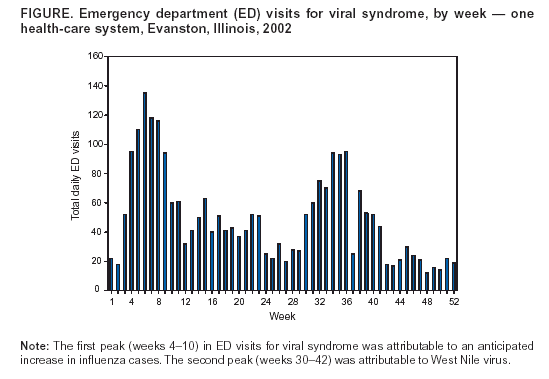 |
|
|
|
|
|
|
| ||||||||||
|
|
|
|
|
|
|
||||
| ||||||||||
|
|
|
|
|
Persons using assistive technology might not be able to fully access information in this file. For assistance, please send e-mail to: mmwrq@cdc.gov. Type 508 Accommodation and the title of the report in the subject line of e-mail. Correlation of West Nile Virus Infection with Emergency Department Chief Complaints by Using a Passive Syndromic Surveillance ModelJohn Flaherty, M. Gillam
Corresponding author: John Flaherty, Evanstone Northwestern Healthcare, 2650 Ridge Rd., Evanston, IL 60201. Telephone: 847-570-2114; Fax: 847-634-1693; E-mail: jjflaherty@northwestern.edu. AbstractIntroduction: West Nile virus infection appeared diffusely in Illinois in 2002, with >800 cases and 63 deaths. This number of confirmed cases was the highest in the nation and resulted in triple the number of deaths of any other state. Objectives: This study used a passive syndromic surveillance model to analyze emergency department (ED) patient chief complaints of fever and headache, influenza-related symptoms, and viral syndrome, and correlate these data with known West Nile virus cases and with the epidemic curve of confirmed cases in northern Illinois. Methods: A passive syndromic surveillance system using a computerized patient log was implemented. A retrospective cohort study used structured query language (SQL) queries to search for patient chief complaints of fever and headache, influenza-related symptoms, or viral syndrome. Positive matches were compiled in a graphical and geographic database. Results: SQL queries revealed a biphasic distribution, with a first peak corresponding to influenza cases during the second week of February and a second unexpected peak during the second week of September 2002 (Figure). Geocoding and frequency analysis matched the confirmed outbreak. A majority of these patients were discharged, and no deaths occurred. IgM serology was positive in 5% of cases. Statistical analysis determined no significant differences in distribution and a coefficient of determination of 0.67. Conclusion: Passive syndromic surveillance systems can retrospectively detect West Nile virus infection. The system was able to detect an increase in syndromic cases in the ED during a confirmed outbreak of West Nile virus. Further study is needed to quantify this effect. Serologic confirmation will also aid in validation. Figure  Return to top.
Disclaimer All MMWR HTML versions of articles are electronic conversions from ASCII text into HTML. This conversion may have resulted in character translation or format errors in the HTML version. Users should not rely on this HTML document, but are referred to the electronic PDF version and/or the original MMWR paper copy for the official text, figures, and tables. An original paper copy of this issue can be obtained from the Superintendent of Documents, U.S. Government Printing Office (GPO), Washington, DC 20402-9371; telephone: (202) 512-1800. Contact GPO for current prices. **Questions or messages regarding errors in formatting should be addressed to mmwrq@cdc.gov.Page converted: 9/14/2004 |
|||||||||
This page last reviewed 9/14/2004
|